Do you have a question about the Danby DPA080HE3WDB-6 and is the answer not in the manual?
Guidance for installation, troubleshooting, and maintenance assistance.
Access self-service tools, FAQs, and more by searching your model number.
Fill out the web form at www.danby.com/support for expert assistance.
Contact customer service via phone, noting potential hold times during peak hours.
Essential safety precautions for operating and handling the appliance.
Proper grounding procedures to prevent electrical shock and fire hazards.
Guidelines for safe servicing, handling flammable refrigerants, and work procedures.
Safety checks before working on systems containing flammable refrigerants.
Controlled procedures to minimize risk of flammable gas or vapor presence.
Instructions for maintenance staff and securing the work area.
Using detectors to ensure safety around flammable atmospheres.
Requirement for fire extinguishing equipment during hot work.
Eliminating ignition sources when working with flammable refrigerants.
Ensuring adequate ventilation before and during work on the system.
Ensuring electrical components fit specifications and following service guidelines.
Initial safety checks and component inspection for electrical devices.
Procedure for disconnecting electrical supplies before working on sealed components.
Guidelines for working on intrinsically safe components in flammable atmospheres.
Checks for cabling subject to wear, corrosion, pressure, vibration, or environmental effects.
Prohibiting ignition sources when searching for refrigerant leaks.
Acceptable methods for detecting leaks in systems with flammable refrigerants.
Procedures for breaking into refrigerant circuits and safe removal/evacuation.
Requirements for charging systems with refrigerant, including leak testing.
Essential steps and precautions for safely decommissioning the appliance.
Requirements for labeling decommissioned equipment and refrigerant content.
Recommended practices for safely removing and recovering refrigerant.
List of components and tools required for installation and assembly.
List of necessary tools for the installation process.
Step-by-step guide to assembling the window kit for installation.
Instructions for fitting the window kit into hung or sliding windows.
Overview of the appliance's key features and components.
Guidance on proper placement and clearance requirements for the appliance.
Explanation of buttons and functions on the appliance's control panel.
Description of indicators and symbols on the appliance's display panel.
Instructions for operating the appliance in cool mode.
Instructions for operating the appliance in dry mode.
Instructions for operating the appliance in fan mode.
Instructions for operating the appliance in heat mode.
How to set the timer function to turn the appliance on or off.
Instructions for activating and deactivating the child lock feature.
Explanation of the sleep feature for energy conservation during operation.
Instructions for using the remote control's thermostat feature.
Description of the remote control buttons and their functions.
Explanation of symbols and indicators on the remote control's display.
Step-by-step guide for replacing batteries in the remote control.
Information on FCC compliance and operating conditions for the device.
Methods for draining water from the appliance, including drain plug and continuous drain.
Setting up the continuous drain option for automatic water removal.
Instructions for cleaning the appliance cabinet and avoiding chemical use.
Guidance on cleaning the air filters regularly for efficient performance.
Steps for storing the appliance safely for extended periods.
Information on responsible disposal of the appliance and batteries.
Explanation of error codes (Lt, PF, Ft) and troubleshooting steps.
Recommendation against leaving the AC in place through the winter.
Information on standard wattage and amps found on the unit's rating plate.
When to use the exhaust hose in different operating modes.
Information regarding the prohibition of using extension cords.
Explanation on why the exhaust hose length should not be extended.
When to use the drain hose in different operating modes.
Information on where water drains from the appliance.
Causes of odors and recommended steps to eliminate them.
Troubleshooting steps for when the appliance fails to operate.
Common causes and solutions for insufficient cooling issues.
Explanation of normal operating noises and how to address them.
Troubleshooting steps for addressing odors, including using algaecide tablets.
Details on warranty duration for plastic parts and functional parts.
Procedure for contacting authorized service depots for repairs.
Explanation of service limitations and consumer responsibilities for transport.
Conditions and situations not covered by the warranty.
General conditions that void the warranty or exclude coverage.
Guidance for installation, troubleshooting, and maintenance assistance.
Access self-service tools, FAQs, and more by searching your model number.
Fill out the web form at www.danby.com/support for expert assistance.
Contact customer service via phone, noting potential hold times during peak hours.
Essential safety precautions for operating and handling the appliance.
Proper grounding procedures to prevent electrical shock and fire hazards.
Guidelines for safe servicing, handling flammable refrigerants, and work procedures.
Safety checks before working on systems containing flammable refrigerants.
Controlled procedures to minimize risk of flammable gas or vapor presence.
Instructions for maintenance staff and securing the work area.
Using detectors to ensure safety around flammable atmospheres.
Requirement for fire extinguishing equipment during hot work.
Eliminating ignition sources when working with flammable refrigerants.
Ensuring adequate ventilation before and during work on the system.
Ensuring electrical components fit specifications and following service guidelines.
Initial safety checks and component inspection for electrical devices.
Procedure for disconnecting electrical supplies before working on sealed components.
Guidelines for working on intrinsically safe components in flammable atmospheres.
Checks for cabling subject to wear, corrosion, pressure, vibration, or environmental effects.
Prohibiting ignition sources when searching for refrigerant leaks.
Acceptable methods for detecting leaks in systems with flammable refrigerants.
Procedures for breaking into refrigerant circuits and safe removal/evacuation.
Requirements for charging systems with refrigerant, including leak testing.
Essential steps and precautions for safely decommissioning the appliance.
Requirements for labeling decommissioned equipment and refrigerant content.
Recommended practices for safely removing and recovering refrigerant.
List of components and tools required for installation and assembly.
List of necessary tools for the installation process.
Step-by-step guide to assembling the window kit for installation.
Instructions for fitting the window kit into hung or sliding windows.
Overview of the appliance's key features and components.
Guidance on proper placement and clearance requirements for the appliance.
Explanation of buttons and functions on the appliance's control panel.
Description of indicators and symbols on the appliance's display panel.
Instructions for operating the appliance in cool mode.
Instructions for operating the appliance in dry mode.
Instructions for operating the appliance in fan mode.
Instructions for operating the appliance in heat mode.
How to set the timer function to turn the appliance on or off.
Instructions for activating and deactivating the child lock feature.
Explanation of the sleep feature for energy conservation during operation.
Instructions for using the remote control's thermostat feature.
Description of the remote control buttons and their functions.
Explanation of symbols and indicators on the remote control's display.
Step-by-step guide for replacing batteries in the remote control.
Information on FCC compliance and operating conditions for the device.
Methods for draining water from the appliance, including drain plug and continuous drain.
Setting up the continuous drain option for automatic water removal.
Instructions for cleaning the appliance cabinet and avoiding chemical use.
Guidance on cleaning the air filters regularly for efficient performance.
Steps for storing the appliance safely for extended periods.
Information on responsible disposal of the appliance and batteries.
Explanation of error codes (Lt, PF, Ft) and troubleshooting steps.
Recommendation against leaving the AC in place through the winter.
Information on standard wattage and amps found on the unit's rating plate.
When to use the exhaust hose in different operating modes.
Information regarding the prohibition of using extension cords.
Explanation on why the exhaust hose length should not be extended.
When to use the drain hose in different operating modes.
Information on where water drains from the appliance.
Causes of odors and recommended steps to eliminate them.
Troubleshooting steps for when the appliance fails to operate.
Common causes and solutions for insufficient cooling issues.
Explanation of normal operating noises and how to address them.
Troubleshooting steps for addressing odors, including using algaecide tablets.
Details on warranty duration for plastic parts and functional parts.
Procedure for contacting authorized service depots for repairs.
Explanation of service limitations and consumer responsibilities for transport.
Conditions and situations not covered by the warranty.
General conditions that void the warranty or exclude coverage.
| Type | Portable Air Conditioner |
|---|---|
| Cooling Capacity | 8, 000 BTU |
| Cooling Capacity (W) | 2344 W |
| Coverage Area | 350 sq. ft. |
| Refrigerant | R32 |
| Fan Speeds | 3 |
| Digital Display | Yes |
| Remote Control | Yes |
| Sleep Mode | Yes |
| Timer | 24-hour |
| Filter Type | Washable |
| Power Supply | 115V |
| Power Supply (V/Ph/Hz) | 115V/1Ph/60Hz |
| Power Consumption (Cooling) | 800 W |
| Noise Level (Indoor) | 53 dB |


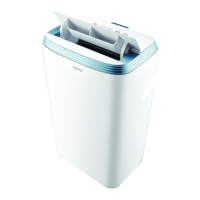
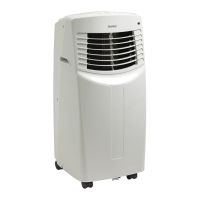
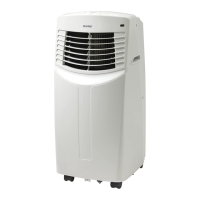
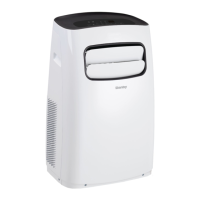
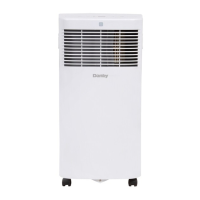
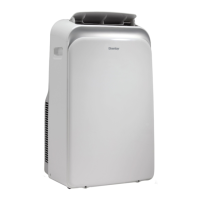

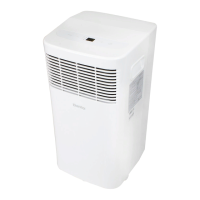
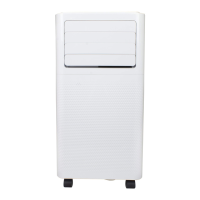

